Vol. 4 No. 16 TROPIC LIGHTNING NEWS April 21, 1969
Index
March Winds Blow Harsh for Enemy
LIGHTNING LION ROARS
CU CHI - The roar of the March lion sounded loud and clear
throughout the third month of 1969 as Tropic Lightning soldiers scored an
impressive number of victories and pre-empted the enemy's promised post-Tet
offensive.
In the largest monthly body count tally since May, 1968, Tropic
Lightning troops killed 1,426 of the enemy and confiscated or destroyed 334
small arms and 149 crew-served weapons.
The enemy's hoped-for post-Tet offensive fizzled miserably due to
aggressive counter-maneuvering, skillful detection and interdiction by Tropic
Lightning.
In the early days of March, the 2d Brigade saw fierce action in the
Citadel area eight miles northwest of Cu Chi. One hundred eighty-seven NVA
were killed in two days of close fighting on March 4 and 5.
The Citadel's patchwork of dry rice paddies crisscrossed with
trees and thorny hedgerows had become an ideal hiding place for the enemy.
He built intricate bunker and tunnel complexes in the area.
To end the Citadel's usefulness as an enemy resting ground,
Tropic Lightning soldiers began helicopter assaults and ground operations in the
area.
On the first day of operations, the 2d Brigade troops jumped off
choppers into hot landing zones with enemy machine gun and RPG fire whizzing
around them. Once in the area, they killed 84 enemy the first day.
Division artillery elements poured over three thousand rounds into
suspected areas of enemy concentration. Demolition engineers blew up over
one hundred bunkers and tunnels.
One action was described as 'just like trench warfare' as
infantrymen fought from dike to dike and bunker to bunker to rout the persistent
and well-entrenched enemy.
After initial assault operations, Tropic Lightning troopers
continued search-and-clear missions in the Citadel the rest of the month,
killing nearly 200 more enemy soldiers and destroying numerous bunker complexes.
Enemy ambush attempts and Tropic Lightning counter-ambush tactics
played a large role in several division activities during March.
Enemy ambush units had tried several times in the last six months
to overtake the division's resupply convoys between Cu Chi and Dau Tieng and
Tay Ninh base camps, at an enormous cost in manpower and munitions.
During March, he tried at least three times more to ambush the
convoy at about the same place, 10 miles northwest of Cu Chi. Not one
attempt did more than slight damage to the convoys and the enemy lost over 200
of his number in the actions.
On March 11, elements of the 3d Brigade stopped an unknown-sized
NVA force as it tried an ambush on a Dau Tieng-bound convoy near the Ben Cui
Rubber Plantation. In a winning combination that was to be employed twice
more in the month, infantry, artillery, gunships and air strikes routed the
enemy unit and killed 76. The convoy was hardly even slowed by the attempt
and no major damage was done.
Cavalrymen from Tropic Lightning's 3d Squadron, 4th Cavalry
played a major role in stopping the second large-scale ambush attempt on March
25. Responding to a call from a Tay Ninh bound convoy that had been hit in
the same area as the other convoy, the horsemen moved in from their position to
the north.
Division armor moved from the south and caught Charlie in a deadly
squeeze. The result: 86 North Vietnamese killed in action, four suspects
detained, nine AK-47 assault rifles confiscated, as well as a complete 82 mm
mortar tube and an assortment of ammo. On March 29 the Cav cost the enemy
another 77 lives.
Major General Ellis W. Williamson, division commanding general,
praised all elements involved "They jumped on the enemy so quickly that he
never had a chance," he said. "The Provost Marshal kept the column
moving while the armor hit him from the south and the cavalry from the north.
Air, artillery, and gunships all worked in unison in a smooth, professional
manner to rout the enemy completely."
Elements of the 3d Brigade spent much of the month in an operation
designed to clear enemy-infested portions of the Michelin Rubber Plantation,
three miles east of Dau Tieng.
Like the Citadel, the rubber tree groves of the Michelin area had
become a favorite hangout for Charlie. He could hide in trees and build
bunkers on the ground knowing that the thick foliage would give him cover.
But in March his rubber grove lair became a more precarious roost.
Earlier in the month 86 NVA were killed in a battle with infantrymen which began
after Dau Tieng base camp had been hit with rockets' from the location deep in
the plantation.
As, the month ended numerous bunker and tunnel complexes were being
destroyed as the clearing operations continued, and the Trapezoid area, just
south of the Michelin Plantation, was hit with over 70 light bombing sorties in
an attempt to end its usefulness as an enemy hiding ground.
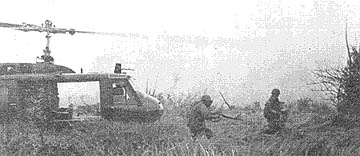 |
PART OF MARCH ACTION - Wolfhounds from the 2d Battalion, 27th Infantry, scramble from a Crusader slick to assault suspected enemy position. The lightning soldiers were searching an area suspected as a launching site for Tay Ninh-bound enemy rockets and mortars. (PHOTO BY SP4 KARL KARLGAARD) |
Hot LZ? Waste, No Chatter!
TAY NINH - "We've got a hot LZ here."
Those words, as chilling as any that ever crackle out of a radio in
Vietnam, were part of a many-sided combat conversation as infantrymen from the
1st Brigade and a South Vietnamese Popular Forces Company carried the war to the
North Vietnamese in an airmobile assault 15 miles southeast of Tay Ninh.
This is how the conversation sounded, from the arrival over the
landing zone of the command-and-control (c-and-c) helicopter carrying the
American battalion commander Lieutenant Colonel Leo L. Wilson of Salina, Kans.,
through the end of the operation. The participants, and their call signs
(not those actually used):
"52" - Wilson; "84" - Major Harry D. Ray Jr. of Dillon,
Mont., operations officer; "73" - Captain Georld Knapp, MACV advisor
with the Popular Forces company; "96" - First Lieutenant Mark E. Barker of
Ravensdale, Wash., the battalion's artillery liaison officer: "Palooka" - the artillery element supporting the infantrymen.
(Continued on Back Page)
Togetherness Now an Army Habit
CU CHI - The uncommon heroism of saving a buddy's life is not
uncommon in the Tropic Lightning Division, but when Warrant Officer Terry Hansen
saved the life of Warrant Officer Glenn Gouge, it was a capstone on a long
pillar of coincidences.
Both men attended flight classes at Ft. Walters and Ft. Rucker in
the same sections of the same classes.
Both men came to Vietnam on the same orders, in the same plane.
And both were posted to the same unit, 3d Squadron, 4th Cavalry;
both wound up in D Company.
Since the two often flew in the same aircraft, a LOH, they
naturally shared a hootch. And, one day when they were flying a mission, their
aircraft came under enemy fire which wounded both men in the legs. Gouge
was seriously disabled, but Hansen managed to fly the craft back, preserving the
two for further parallels.
Both - of course - were taken to the 12th Evacuation Hospital and
shared the same evacuation out of country.
Both (can one doubt it?) will be heard from again in some joint
undertaking.
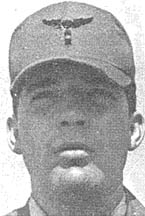 |
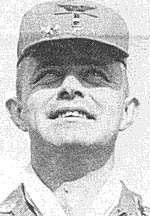 |
| WO Glenn Gouge | WO Terry Hansen |
| Almost any season in Vietnam is the swimming pool season, if the facilities are available. For those who are fortunate enough to have access to a pool, safety is imperative. Most pools have a set of rules posted. It's only good sense to follow those rules religiously. Anyone who doesn't is all wet. |
Page 2 TROPIC LIGHTNING NEWS April 21, 1969
Decorated
| BRONZE STAR MEDAL (HEROISM) |
|
| PSG Robert C. Lewis, C
Trp, 3d Sqdn, 4th Cav SFC Nathaniel E. Meador, Co C, 1st Bn, 27th Inf SFC Herbert D. Wright, Co C, 1st Bn, 27th Inf SSG David D. Buckner, HHC, 1st Bn, 27th Inf SSG Stephen B. Duerk, Co B, 1st Bn, 5th Inf SSG Emmanuel G. Montanez, A Trp, 3d Sqdn, 4th Cav SSG Tommy Brewington, A Trp, 3d Sqdn, 4th Cav SSG Levern C. Brown, A Trp, 3d Sqdn, 4th Cav SSG Jack B. Kimberlin, B Trp, 3d . Sqdn, 4th Cav SSG Alejandro, Co D, 3d 22d Inf SSG William D. Shaw, Co A, 3d Bn, 2d Inf SSG Ronald D. Hughes, A Trp, 3d Sqdn, 4th Cav SSG Thomas E. Kelly, Co A, 2d Bn, 12th Inf SSG Bernard R. Gdowski, Co C, 1st Bn, 5th Inf SP6 Tommy D. Bass, HHC, 1st Bn, 27th Inf SGT Billy R. Terry, Co A, 1st Bn, 27th Inf SGT La Von Freeman, Co B, 1st Bn,. 5th Inf SGT Lowell E. Leopold, Co D, 2d Bn, 12th Inf SGT Cecil G. Law, Co B, 1st Bn, 27th Inf SGT William J. Haase, Co D, 2d Bn, 12th Inf SGT Roy L. Alexander, Co A, 1st Bn, 5th Inf SGT Timothy Harris, Co A, 1st Bn, 5th Inf SGT Daniel Rothstein, Co A, 2d Bn, 14th Inf SGT William A. Cargill, 25th MP Co SGT Jerry E. O'Malley, A Trp, 3d Sqdn, 4th Cav SGT Mel T. Bernard, Co F, 50th Inf SGT Gerald J. French, B Trp, 3d Sgdn, 4th Cav SGT Terry Valore, HHC, 4th Bn, 23d Inf SGT Daniel G. Updike, Co A, 4th Bn, 23d Inf SGT Glenn D. Covert, Co A, 2d Bn, 14th Inf SGT David H. Ross, Co E, 2d Bn, 12th Inf SP5 Donald E. Deck, A Trp, 3d Sqdn, 4th Cav SP5 Thomas E. Ruschkewitcz, C Trp, 3d Sqdn, 4th Cav |
SP4 Richard H. Losey, HC, 1st Bn, 27th Inf SP4 Guy S. Lopez, HHC, 1st Bn, 27th Inf SP4 James A. Leonard, HHC, 1st Bn, 27th Inf SP4 Larry P. Templeton, Co A, 4th Bn, 9th Inf SP4 Dennis A. Gilmore, Co A, 1st Bn, 27th Inf SP4 Carlton G. Harwell, Co B, 1st Bn, 5th Inf SP4 Jerome L. Bradwell, Co B, 1st Bn, 5th Inf SP4 Kenneth J. Taylor, Co D, 2d Bn, 12th Inf SP4 William C. Stuart, Co D, 2d Bn, 12th Inf SP4 Perry A. Helms, Co B, 1st Bn, 5th Inf SP4 Robert O'Kelly, A Trp, 3d Sqdn, 4th Cav SP4 Ronald D. Martin, C Btry, 7th Bn, 11th Arty SP4 Roy A. Montanaro, Co A, 1st Bn, 5th Inf SP4 Monte Smart, Co B, 1st Bn, 5th Inf SP4 Jimmy Sanford, C Trp, 3d Sqdn, 4th Cav SP4 Michael W. Barks, Co D, 2d Bn, 12th Inf SP4 Douglas J. Kearse, Co B, 4th Bn, 23d Inf SP4 Arthur J. Park, Co A, 2d Bn, 14th Inf SP4 Thomas R. Drew, Co C, 2d Bn, 14th Inf SP4 Kit R. Keeler, Co B, 1st Bn, 27th Inf SP4 Rafael Gomez, B Trp, 3d Sqdn, 4th Cav SP4 Julian G. Gamache, Co A, 1st Bn, 5th Inf SP4 Robert D. Ashton, Co C, 2d Bn, 14th Inf SP4 Ezequiel E. Garcia, Co C, 2d Bn, 14th Inf SP4 Gary W. Sheets, Co C, 1st Bn, 5th Inf PFC Kenneth Davis, Co B, 4th Bn, 23d Inf PFC James E. Mead, Jr., Co B, 4th Bn, 23d Inf PFC Jimmy M. Winter, Co D, 2d Bn, 12th Inf PFC Benny A. Ashley, Co A, 4th Bn, 9th Inf PFC William Ryver, Co A, 1st Bn, 27th Inf PFC Dale V. Elling, Co B, 1st Bn, 5th Inf PFC Henry Jones, Co D, 2d Bn, 12th Inf |
U.S. Savings Bonds Are Investment in Security
"Take stock in America," reads the current U.S. Savings Bond
and Freedom Shares sales slogan, and the fact is that today no one planning for
his financial future can afford not to take savings bonds into account.
A combined bond and freedom share program pays interest competitive
with bank rates and is secured by the full faith and credit of the United States
government. Bonds are replaced by the government if lost, destroyed or
stolen.
The payoff comes in seven years when the 4 ¼ per cent interest
rate pays you about four dollars for every three you put in. And buying
savings bonds secures you the privilege of purchasing the higher paying, 5 per
cent interest Freedom Shares in combination with your bonds.
United States Savings Bonds are exempt from state and local taxes,
and, if you choose not to cash them on maturity, they will continue to collect
the same 4 ¼ per cent interest as long as you hold them.
While the spectacular gains associated with the stock market cannot
be claimed for bonds, those shares in America offer, a security lacking in the
market.
Stocks can and often do decline in value, sometimes quickly.
But if you invest in a bond, it will never be worth less than what you paid for
it. In a financial emergency you will find bonds a more dependable friend
than that block of Global Imponderables, Inc. you bought for 68l, which is now
selling for 3.
No other form of savings is so well protected against fire, theft,
destruction and cyclical economic fluctuations and a savings bond plan.
In addition to total security and a prospect of a financially
comfortable future, the investor in U.S. Savings Bonds can reserve further self
satisfaction: that of active patriotism.
In helping our government into a stronger position to meet its
international and domestic obligations and reducing the buying power squeeze on
his fellow citizens, the buyer of savings bonds may well congratulate himself on
his foresight and citizenship.
Tropic Lightning Tots
The Commanding General Welcomes
The Following Tropic Lightning Tots
To The 25th Infantry Division - As
Reported By The American Red Cross.
Born To:
| March 27 PFC Mearl D. Caudill of Co B 2/14 Inf, a daughter March 28 1LT Herbert E. Schweppe of D Btry 3/31 Arty, a daughter PFC Thomas E. Mauck of Co D 2/27 Inf,,a son April 1 SGT Paul A. Estep of HHC 2/12 Inf, a son |
April 1 PFC Joseph N. Brooks of 25th Admin Co, a son SP5 Allen L. Gordon of Co A, 725th Maint Bn, a daughter April 3 1LT John A. Graham III of Co E 2/14 Inf, a son April 7 PFC Jimmy H. Morgan of HHB 1/8 Arty, a son |
Chess Tourney Slated for Nov.
Plans for the Tenth Annual Armed Forces Championship Chess
Tournament, to be held in Washington, D.C., Nov. 7-15, 1969, have been announced
by Walter J. Fried, President of the American Chess Foundation.
As in 1968, the plan for this year calls for each service team to
consist of six finalists, to meet in 12 rounds of team play for the Thomas Emery
Championship Trophy.
Since the Army gained permanent possession of the Emery cup last
year by winning for the third year in succession, there will be a new Emery
award for 1969, the third time since the series began years ago.
Air Force holds the first by virtue of winning in the three years
previous to Army's winning streak.
Anyone on active duty is eligible to try for a service team.
(AFPS)
Hawaiian R&R Officer Can Make Reservation
A problem with the R&R program in Hawaii is that many wives
going there to join their husbands on R&R make hotel reservations through
travel agencies in their home towns. This costs them money in fees and it
is not always a guarantee that they will get the accommodations they want at the
rates they want to pay. Sometimes, reservations are not even made for
them.
It is entirely unnecessary for such things to occur. The
R&R Center at Ft. DeRussey in Hawaii is capable of making the reservations for you at no
fee.
If you or your wife make reservations for hotel accommodations
through Ft. DeRussey, you can always be certain of getting what you want.
If, you any reason, you find that the accommodations were not what you had
anticipated, the R&R staff will immediately go into action to satisfy your
complaints. Taking advantage of the R&R Center's reservation
facilities will save time.
For reservations, you or your wife should write to the
Officer-in-Charge, Ft. DeRussey, APO San Francisco 96558, as soon as you
are sure of exactly when you will arrive in Hawaii.
Include information on how much you would be willing to spend, what
type of accommodations you would like and the number of adults and children to
be accommodated.
If your dependents arrive in Hawaii before you, they may stay in
the billets at Ft. DeRussey or the dates of your reservation can be extended to
cover their arrival.
Be sure to include your complete mailing address in all
correspondence to the R&R Center.
The TROPIC LIGHTNING NEWS is an authorized publication of the 25th Infantry Division. It is published weekly for all division units in the Republic of Vietnam by the Information Office, 25th Infantry Division, APO San Francisco 96225. Army News Features, Army Photo Features, Armed Forces Press Service and Armed Forces News Bureau material are used. Views and opinions expressed are not necessarily those of the Department of the Army. Printed in Tokyo, Japan, by Pacific Stars and Stripes.
MG Ellis W. Williamson . . . . Commanding General
MAJ John C. Fairbank . . . . . Information Officer
1LT John C. Burns . . . . . . . . Officer-in-Charge
SP4 Robert Imler . . . . . . . . . . Editor
SP5 Charles Withrow . . . . . . Assistant Editor
SP4 Jim Brayer . . . . . . . . . . . . Production Supervisor
Page 3 TROPIC LIGHTNING NEWS April 21, 1969
Cong Taste Bitters Of 'Hound Ambush
DAU TIENG - The enemy got a taste of his own medicine when Charlie
Company, 1st Battalion, 27th Infantry Wolfhounds turned tables on him and sprung
an ambush near Dau Tieng.
The successful ambush accounted for four dead enemy soldiers and
one detainee and climaxed a two-day operation by the 25th Infantry Division's
3d Brigade troopers.
"We beat Charlie at his own game in his own area this time,"
said First Lieutenant Clyde Oatts of Los Angeles, Calif., a forward observer
with Charlie Battery, 2d Battalion, 77th Artillery. "We pulled the
ambush on him and turning the tables really worked out for us."
Much of the credit for the successful ambush had to go to the men
of Charlie Company who reacted with precision and professionalism, according to
First Lieutenant Delbert W. Roe of Grand Prairie, Texas, Charlie Company's 2d
platoon leader.
"Due to the alert and quiet movement of our unit we were able to
engage the VC in his territory at our advantage," he said.
Just before the ambush was sprung, Private First Class Jose T.
Zapata of Berrien Springs, Mich. and his buddy, Specialist 4 Patrick Tobin of
Minneapolis, Minn., were swatting mosquitoes.
"Funny how quickly we forgot about those mosquitoes when we saw
the VC coming," Zapata said.
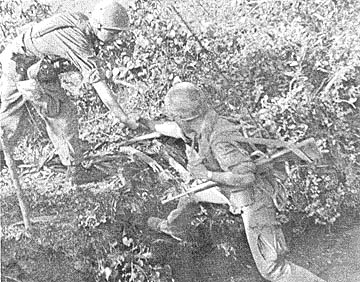 |
ONE BIG STEP - A 2d Brigade soldier helps a fellow infantryman take that one step from the wet canal to the dry bank. The action occurred west of Cu Chi. (PHOTO BY 1LT J.N. BLACK) |
Charlie Has a Better Idea
Would You Buy A Used Car From This Man?
By SP4 Robinson Truitt
CU CHI - It was out in the middle of nowhere; no houses, nothing
but the jungle and thick underbrush, of the Boi Loi Woods.
Sheridan tanks and armored personnel carriers of Bravo Troop, 3d
Squadron, 4th Cavalry were jungle busting their way through the thick vegetation
in search of enemy bunkers and caches.
Private First Class Timothy E. Rice of Aurora, Ind., was poking his
way through the entangled growth on foot when he came across a rather amazing
sight.
"Hey sarge, c'mere. I've found a '37 Ford."
"Uh huh."
"...and it's all dismantled."
"Roger that."
When Staff Sergeant Jackie B. Kimberlin of Dayton, Ohio, managed to
crawl through the underbrush to where PFC Rice was standing, there indeed he
found the parts of a '37 Ford. And they were in good condition.
The paint was shiny on the body surfaces and the mechanical parts were well
lubricated. Everything was there except for the seats. There was
evidence that part of the car had been forcibly dismantled, like maybe by an
airstrike.
"The parts were scattered all over the place," said Rice.
"Some were found in a caved-in bunker, the rest just lying out in the open.
But they were in good condition. What gets me is trying to figure out how
Charlie got that car in there in the first place. And what would he want
with it there?"
Perhaps he was waiting for an air strike to clear away the jungle
so that he could drive it out. A short distance away in a bunker were
copies of Stars and Stripes dating from Feb. 8 to Feb. 13. After all,
that's as good as anything to read while waiting on your wheels.
"I don't know. . ." added Rice, staring at his feet. "I can't figure ol' Charles out any more. He really blows my mind.
A '37 Ford in the middle of the Boi Loi Woods.
"You know, I can't get any sleep; I just lie on my cot trying
to figure out how he ever got it in there."
| TIGHT SQUEEZE - Staff Sergeant Robert J. Johnson, of Xenia, Ohio, crawls out of Viet Cong tunnel after inspection for hidden enemy troops. Johnson is with 2d Battalion, 12th Infantry, which discovered the tunnel during Duc Hoc operations. (AFPS) | 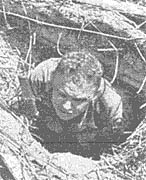 |
Engineers Get Cache
CU CHI - While laying wire in a dried up rice paddy between the
third and fourth rows of perimeter wire at Fire Support Base Keene, a group of
engineers from the 2d Brigade came across some rusty containers that yielded a
cache of enemy rockets.
Specialist 4 Thomas R. Sutton of Tucson, Ariz., was securing a
section of commo wire when he noticed a long rusty object buried in the dirt
next to his foot.
After. he dug it up, Sutton turned it over to Master Sergeant
Martin Barber of Cross City, Fla., the mission operations sergeant.
Barber opened the container and pulled out a 122mm rocket.
This discovery led to a probe of the entire rice paddy area and seven more
containers with rockets inside were discovered.
Woman Tips Armor Off To VC Trap
TAY NINH - Sweeping out of the Boi Loi Woods, tanks from the 2d
Battalion, 34th Armor were met by a Vietnamese woman who had left the security
of her village and walked over 250 yards of open rice paddies to warn the Tropic
Lightning soldiers of a trap.
Through motions and a few understood words, the armormen were told
that VC were planting many large mines on the road to their front.
Then after knowing the GI's understood her message the woman
scurried back to her hut.
First Lieutenant Charles Sollars of Linton, Ind., a platoon leader,
relayed the woman's information down the line and a minesweep team came to
check out the road. Within thirty paces of the lead tank the mine detector
began to register a find.
A close search revealed a 40 lb anti-tank mine buried just under
the surface. The engineers detonated the mine in place.
The armor pulled into a single file line, and before they reached
their destination they found four more of the mines.
Up Tight Fires Half Millionth
DAU TIENG - Half a million rounds later and the men of 2d
Battalion, 77th Artillery are still "Up Tight."
Five hundred thousand rounds ago, "Up Tight" gunners began
pounding Charlie near the 3d Brigade base camp at Dau Tieng. Of those
500,000 firings, only one differed significantly from the rest - the last one.
That was the ceremonial firing of the half millionth round to be
loosed against the enemy since the battalion began operations two and a half
year ago.
Colonel John Weiringa of Palisades Park, N.J., division artillery
commander; Colonel Louis J. Schelter Jr. of Atlanta, Ga., 3d Brigade commander;
and Lieutenant Colonel Vernon B. Lewis of Marshall, Texas, battalion commander,
all pulled the lanyard that sent the special 105mm round screaming toward the
enemy.
The brightly shined and painted projectile was fired from Alpha
Battery's "Zulu" gun position on the Dau Tieng base camp. That's
the same gun position that just a few weeks ago helped ward off a massive enemy
ground attack that threatened the camp.
A composite crew made up from the battalion's three batteries
loaded the special round into the artillery piece. There to supervise the
loading was Command Sergeant Major Charles Smith of Oakland, Calif., the
battalion sergeant major.
Sergeant First Class Ronald Cooper of Purdy, Mo., who landed in
Vietnam with the original battalion on October 13, 1966, issued the fire
commands. He is on his second tour with the battalion.
"It doesn't seem possible that we could have fired that many
rounds in such a short time, but I guess the area we're in is one of the most
active in Vietnam," he said.
The battalion received a Presidential Unit Citation for its action
in the Battle of Soui Tre during Operation Hawthorne in 1968. In the wake
of the 1968 Tet offensive, the battalion rushed to Saigon and helped turn the
tide in favor of the Allies.
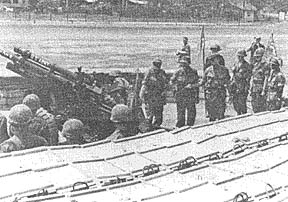 |
THE VIP FIRING CREW at the lanyard sends the half millionth round fired by the 2d Battalion, 77th Artillery screaming towards an enemy target. The gunners are Colonel Louis J. Schelter Jr., 3d Brigade commander (left), Colonel John Weiringa, division artillery commander, and Lieutenant Colonel Vernon B. Lewis, battalion commander. (PHOTO BY SP4 LARRY LOVELOCK) |
Page 4-5 TROPIC LIGHTNING NEWS April 21, 1969
725th Maint Bn Keeps 'em Rolling, Flying
Why Does the Tropic Lightning Division have the highest
operational ready status for aircraft of any division in Vietnam?
Why is the amount of division equipment deadlined or evacuated at
an all time low?
Everyone probably has a pretty good idea. The secret involves
the 725th Maintenance Battalion living up to its motto of 'Service to the
Line.'
During the past year 'Service to the Line' has meant repairing
over 57,000 pieces of division equipment in Cu Chi, Dau Tieng and Tay Ninh in
direct support of the three Tropic Lightning brigades.
At the beginning of April the battalion recorded its lowest backlog
figure in two years with only 244 pieces of equipment deadlined or evacuated.
Compared to the 26,657 equipment units in what is called the
division density, 244 is an exceedingly low figure for a combat operation.
The high operational status for division aircraft is on the coup
stick of E Company, responsible for maintaining the airworthiness of Tropic
Lightning aircraft. Considering its responsibilities, its no surprise to
note that the 725th Maintenance Battalion is the largest battalion in the
division.
In addition to its mission of repair and maintenance, the 725th operates
a massive technical supply system, and, when the situation demands, will build a
new bit of equipment to suit a new tactical idea.
Under development now is a new concept in gunship support to
augment existing methods of landing zone preparation.
In fact, one of the best tributes to the 725th Maintenance
Battalion lies not in the outstanding job it lavishes on its day-to-day duties
and the maintenance of existing weapons system but in the flexibility with which
it tackles the alteration and execution of devices merely contemplated.
|
Photos By SP4 Gary Kwiencinski |
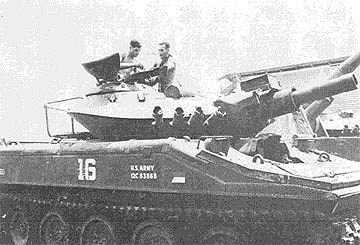 |
SHERIDAN - Among the routine adjustments the 725th makes are settings on the M88 pack of the new Sheridan tank. |
| UP AND AWAY - When vehicles are so far gone as to be utterly immobile on their own, the 725th relies on the Hulk, designed as a tank retriever, which easily lifts five tons straight up. | 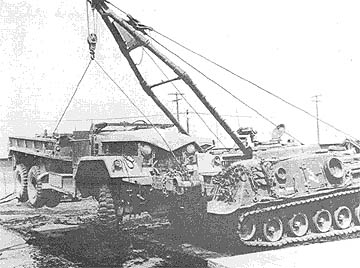 |
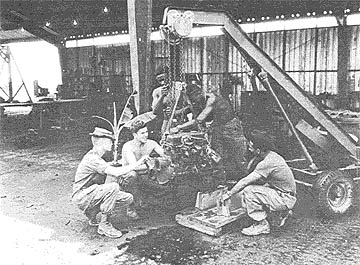 |
LIFT - An M-151A Engine is swung out onto a wooden frame for repairs. |
| COBRA - Company A of the 725th regularly works with such terrors. This one needs minor adjustments to the head assembly. | 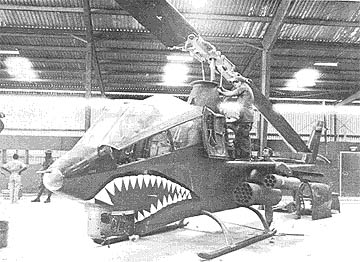 |
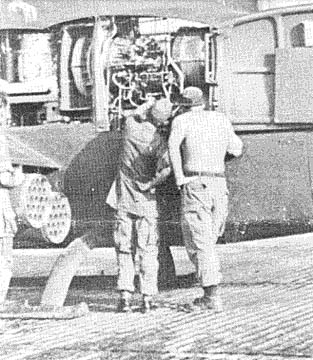 |
CHECK UP - A 3d Squadron, 4th Cavalry gunship is also in the province of the 725th. The Cavalry is not an organic unit to the division, but the Battalion handles 3d and 4th echelon maintenance. |
Page 6 TROPIC LIGHTNING NEWS April 21, 1969
Dau Tieng Boasts Red Hot fire Dept
DAU TIENG - It doesn't take firemen of the 3d Brigade long to get
their feet wet - but their full duty schedule keeps them out of hot water.
The five-man fire fighting team of the 142d Engineer Detachment at
Dau Tieng is on 24-hour alert. Their responsibility: to protect the Dau
Tieng base camp and aircraft in the area from fire and the threat of fire.
In addition to fighting fires in the base camp area, the team also
responds, on a voluntary basis, to fires in Dau Tieng village.
For example, just last month the firemen dumped more than 20,000
gallons of water on a Michelin rubber processing factory nearby. The fire
was brought under control after five hours.
"My men are doing a fine job with the equipment they have,"
said Sergeant Jack McGee of Chicago. "For the future, I want to set up a
definite fire prevention program for the GIs and the local villagers," he
said.
The 3d Brigade fire department has been in operation for over a
year and a half. All the men on the team received 10 weeks of fire
fighting training at Ft. Lewis, Wash., before coming overseas.
Wake Up Charlie
CU CHI - "A place to sleep" for the enemy has been destroyed by
the 65th Engineer Battalion.
The engineers conduct operations in a section of the embattled
Citadel area six miles northwest of Cu Chi. The enemy knew the area as
"nho sano" - literally "a place to sleep". But he won't be
getting much rest there from now on.
Tropic Lightning bulldozers uncovered caches of medical supplies,
uniforms, intelligence information, and booby traps ranging from small
anti-personnel mines to 105mm rounds.
The engineers' bulldozers took over and leveled the area,
uncovering spider holes, tunnels, and bunkers by the dozen. Demolition
specialists were put to work to insure complete destruction of the enemy
positions and facilities.
Now that Charlie's hotel in the Citadel is being demolished, he
will have to look elsewhere for accommodations.
'Happy Anniversary George'
. . . Love, Sheila
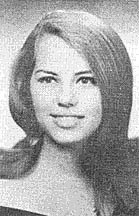 The Tropic Lightning News can now report another first, one that
lands it squarely in the big leagues of journalism. After more than two
years of jungle-oriented publication, we have received a letter to the editor.
The Tropic Lightning News can now report another first, one that
lands it squarely in the big leagues of journalism. After more than two
years of jungle-oriented publication, we have received a letter to the editor.
Sheila Davis of Old Bethpage, N.Y., sent us her picture and asked
that it be used to convey anniversary greetings to Private First Class George P.
Geranios of the 4th Battalion, 9th Infantry Manchus. George is her fiancé
and the anniversary is presumably of their first date.
Sheila's request is, on the surface, quite reasonable.
However, it brings with it many problems.
The whole matter has in fact been gravely debated in the highest
levels since the reception of her request.
Eventually several alternatives emerged, all enjoying some support.
1. Grant Sheila's request. This position had little chance
of success, for a large majority rightfully considered that to do so would touch
off a veritable avalanche of similar requests. Space limitations of our
paper would prohibit such announcements.
2. Refuse Sheila's request. This position lacked the
chivalry that marks the spirit of the Tropic Lightning Division. "It's
a little like being against apple pie and mother," one gallant staffer
offered.
3. Print the anniversary wish but not the picture. This
position was held to be schizophrenic, so naturally found many supporters.
4. Print the picture but not the anniversary wish. Comments
above generally apply here, but it should be noted that it has suggested a whole
new field of research to Army psychologists.
It is, after all, impossible to print all the anniversaries of all
persons in the division and attached units.
The decision was finally reached not to print either Miss Davis'
greeting or her picture. Happy Anniversary George and Sheila.
94th Maintenance Bn Keep Dau Tieng A-OK
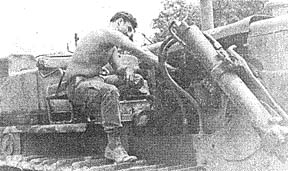 |
| TIGHTEN UP - Specialist 5 Reinhard Zuber of Brooklyn makes an adjustment on a caterpiller. (PHOTO BY SP4 JACK R. ANDERSON) |
DAU TIENG - 'One stop maintenance' isn't an idle
boast by members of the 94th Maintenance Company's Dau Tieng contact team -.
it's their way of life.
The team that can 'fix anything almost,' provides maintenance
support for all non-25th Infantry Division troops at the 3d Brigade's Dau
Tieng base camp. When they say no job is too big or too small, that's just
what they mean.
They'll repair anything from a giant dirt dozer to a tiny radio
transmitter with the result being a refurbished piece of equipment that works as
good as new.
These handymen are a group of highly trained maintenance
specialists versed in a number of repair MOSs. For example, the team has
on-call two turret mechanics, two automotive specialists who work on both wheel
and track vehicles, a radio repairman, telephone and wire repairmen, a welder
and a chemical equipment repairman.
"The men work so closely together that they soon learn many of
the basics of the other maintenance jobs we perform," said First Lieutenant
Dean S. Downer of Shrewsbury, Mass., the team's officer in charge.
"In this way, each man gets valuable cross training that adds to
the effectiveness of our mission here at Dau Tieng," he said.
A typical day may find the repairmen working on everything from
small arms to highly sensitive artillery sights.
"We can't repair everything," Downer said. "Some equipment
such as medical instruments, automatic data processing machines, aircraft and
air delivery parts we can't handle here. But just about anything else
you can name, we can repair," he said.
Maintenance is a must in Vietnam, and the jacks-of-all-trades of
the 94th Maintenance Company's contact team are providing units around Dau
Tieng with precision workmanship and on-the-spot repairs necessary for the
trouble-free performance of a myriad of machines.
Page 7 TROPIC LIGHTNING NEWS April 21, 1969
Tropic Lightning Brings New Playground to Cu Chi Kids
CU CHI - The Civil Affairs Section of Division Headquarters,
arranged for the use of a grader last week to clean the area round Cu Chi High
School in preparation for a playground to be constructed there later this
spring.
The area, which is the proposed site for three new schools, was
covered with the rubble of heavy construction. Working with Major Stan
Curbow, Senior District Advisor, and Major Juan Benitez, Division Transportation
Officer, Captain William Menzel of the Division Support Command S-5 section
arranged to bring the busy grader to the school on Sunday afternoon.
With a Vietnamese boy riding "shotgun," a Tropic Lightning
engineer cleared the area to a level plain, paving the way for the next project
- the construction of swings, see-saws, and other playground items.
First Lieutenant Trung Luat, a Cu Chi District staff officer
representing the village chief, explained that in the past the rubble around the
school had made it difficult for the children to play safely.
"We discovered that the only area they had was in the middle of
the construction zone, not a safe area at all," said Luat. "Now that
the land has been cleared we hope to provide them with a real playground."
Watch Out Charlie
More's a Comin'
DAU TIENG - "Uptight" cannoneers from two batteries of the 2d
Battalion, 77th Artillery, fired more than 24,400 rounds in two weeks - a lot of
high explosive trouble for Charlie.
Alpha and Charlie batteries firing from both the 3d Brigade base
camp at Dau Tieng and Fire Support Base Mahone expended a total of 23,934 high
explosive rounds from February 22 to March 7.
In addition to the high explosive rounds fired, the two batteries
fired 320 illumination rounds and 213 marking rounds.
All were fired from 105mm artillery pieces.
"The last month has been pretty busy for us, but we'll be ready
again next month to help out the infantry units we fire in support of - even if
it means topping the old record," said Lieutenant Colonel Vernon B. Lewis of
Marchell, Tex., battalion commander.
The "Uptight" battalion has operated in the III Corps area
since it arrived in Vietnam two and a half years ago. The battalion won a
Presidential Unit Citation for the Battle of Soui Tre during Operation Hawthorne
in 1968.
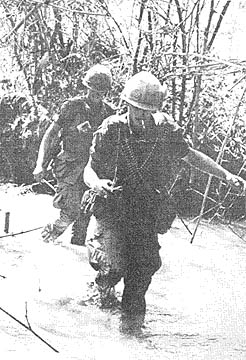 |
EVEN IN THE DRY SEASON, 2d Brigade infantrymen manage to get their feet wet. Specialist 4 William D. Berry of Oklahoma City, Okla. (front), and Specialist 5 Robert R. Pocrus of Sherril, Ark., cross a small river near Tay Ninh City. (PHOTO BY SP4 R. B. WILLIAMS) |
Lancers In Jungle Fight
TAY NINH - Deep in the jungle of the Crescent area nine miles
northeast of Tay Ninh City, elements of the 1st Brigade fought a fierce battle
with an unknown-sized enemy force.
After placing their armored personnel carriers in a night laager,
the Tropic Lightning soldiers spread out to search the tangled overgrowth.
While moving through the jungle, they received small arms fire from an enemy
trench line. In the ensuing fire fight the Lancer Brigade troopers killed
four enemy.
"This was some of the thickest jungle we've been in. It
was a hard and brief fight but we tore them up good. We suffered only two
minor casualties," said Specialist 4 James Paet of Honolulu, Hawaii.
Boi Loi Is Scene of Action
Cav Pounds NVA in Seven Hour Battle
CU CHI - During close to seven hours of heavy fighting with an
estimated company of NVA, B Troop of the 3d Squadron, 4th Cavalry, succeeded in
overpowering the enemy and destroying his well-concealed base camp.
While on a sweep through a dense portion of the Boi Loi Woods,
about nine miles northeast of Go Dau Ha the Cavalrymen found foot trails, recent
camp sites and freshly opened canned goods. The horsemen cautiously pushed
onward through the heavy underbrush.
Suddenly, enemy fire swept across the Cavalrymen's tracks and
Sheridans. Small arms fire sprayed over the troopers and then a barrage of
rocket-propelled grenades and recoilless rifle fire slammed into the armored
vehicles.
First Lieutenant Michael P. Wesley of Hopkins, Minn., recalls
"The enemy was well camouflaged and firing from bunkers. They were well
dispersed over a wide area and hidden in the dense underbrush. The
troopers had their hands full putting a base of fire on all of them."
The Cavalrymen remained on line at a standstill while they slugged
it out with the entrenched enemy.
The troop moved back to regroup as air and artillery support were
called in. With exceptional accuracy they pounded the enemy positions.
Delta Troop, 3d Squadron, 4th Cavalry gunships poured out minigun fire, and Huey
Cobras lashed out with rocket fire and a screen of M-60 machinegun bullets.
After the final pounding of artillery, the troopers swept over the
battlefield to finish the job.
Still receiving scattered resistance, the horsemen rolled over the
enemy positions, knocking them out one by one by throwing grenades into the
firing ports. The tracks broke through the enemy's first line of defense
leaving the bunkers in shambles.
As the troopers advanced further into the NVA bunker positions,
they were hit from behind. The cavalry's .50 calibers swung around to
return fire and the few remaining bunkers were outgunned and destroyed.
Specialist 4 Thomas Lange of New Baden, Ill., acting commander of
an armored personnel carrier in the second platoon remained cool throughout the
battle. When the APC of one of his comrades was hit by an RPG, Lange
ordered his men to go assist the wounded crew.
He then took over in the driver's hatch while a minesweeper from
the 85th Engineer Battalion manned the .50 caliber machinegun.
No more resistance came from the NVA positions as the Cavalrymen
advanced still further.
A sweep over the battle torn area revealed 28 NVA killed.
Five AK-47 rifles, one RPG launcher and ammunition for the weapons were found in
the destroyed fortifications. An enemy suspect was detained by the
troopers.
Cavalrymen also found food and documents.
| SMOKEY lays down a base of protective smoke to conceal the landing zone as troopers from the 1st Brigade make another combat assault. As Smokey rolls in, destructive fire is placed on both flanks of the incoming choppers by gunships belonging to the "Rat Pack" gunship platoon of the 187th Helicopter Assault Company. (PHOTO BY SP4 DAVID DEMAURO) | 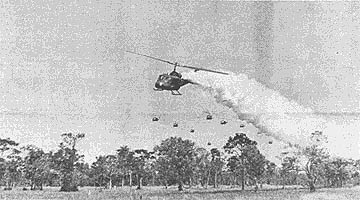 |
Page 8 TROPIC LIGHTNING NEWS April 21, 1969
Kit Carson Scout Wins Bronze Star
In a ceremony at Fire Support Base Wood a diminutive man with the
courage of a regiment of giants was awarded the Bronze Star with V device.
His name is Le Van Be. A Kit Carson Scout with the 2d
Battalion, 22d Infantry's Charlie Company, Be has gone from enemy to friend to
hero, receiving his Bronze Star from the hand of Tropic Lightning commander
Major General Ellis W. Williamson.
Be came to the Triple Deuce company through the Chieu Hoi program.
After he rallied to the government, he volunteered to serve with the men he once
fought.
On January 14th, the men of Charlie company realized how fortunate
they were to have Be serving with them.
While sweeping through the eastern sector of the Cau Cui rubber
plantation, five miles northwest of Dau Tieng, the Triple Deuce company came
under intense enemy machine gun and rocket grenade fire.
Swiftly deploying on line, the mechanized infantrymen and their
personnel carriers began to assault the enemy.
At this point Be leaped from his APC and charged ahead, searching
for the entrenched enemy's positions. He spotted the bunker complex of
an estimated enemy company and began directing fire on their positions.
He repeatedly yelled back to the men manning the .50 caliber
machineguns atop the APCs to fire where he had spotted the camouflaged enemy.
"He led a charmed life that day," recalls Private First Class
Clair Miller of Port Allegany, Pa. "Jumping from the track to the ground
and directing fire as many times as he did sure kept Charlie's head down."
Be continued to direct fire on the enemy until artillery was called
in, and, as the Triple Deuce infantrymen pulled back, the fire rained down on
the enemy.
On the second assault, little resistance was encountered until the
company began sweeping toward the main supply route from Tay Ninh to Cu Chi.
Be was again near the point when he spotted a large group of enemy
soldiers setting up positions along the road in order to ambush the convoy.
He ran to the point and directed fire upon the would be ambushers, thus saving
many lives and preventing an attack on the convoy.
At Fire Support Base Wood, Be, surrounded by his friends, proudly
accepted his award, and his American friends of the Triple Deuce's Charlie
Company were just as proud.
| TWO STRONG MEN - A teamwork that will build a secure and free Vietnam is symbolized as Kit Carson Scout Le Van Be receives a Bronze Star from Major General Ellis W. Williamson. (PHOTO BY SP4 D.J. CALDWELL) | 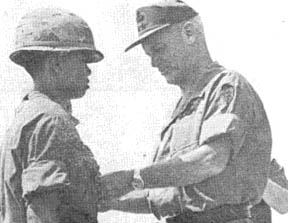 |
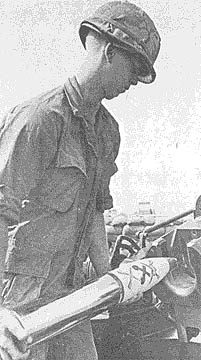 |
THE MEDIUM IS THE MESSAGE - And this highly decorated missive is the 750,000th such message delivered to Charlie by the 1st Battalion, 8th Artillery. Loaded by Private First Class Tom Woodson of Phoenix, Ariz, the round was sent Special Delivery by Major General Ellis W. Williamson who pulled the lanyard. |
No Wasted Words When in a Hot LZ
(Continued From Page 1)
Ray and Barker were with Wilson in the C-and-C helicopter.
Cain and Dias were on the ground with their units. The artillery battery
was two miles away at Fire Support Base Sedgwick. The conversation:
52: "We're right over the landing zone for the first lift."
84: "Roger that. The artillery will be hitting it in a
minute."
52: "Is our first element ready?"
84: "73, this is 84. What is your situation?"
52: "What's the status of the second lift?"
84: "They're on their way. We should be seeing them soon
now."
73: "The mortars are coming again. They've got the first
LZ zeroed in now. We can't put any more people down in there."
84: "Roger that. They'll be setting down to your
November."
73: "Be advised that we are still getting all kinds of fire in on
our young bodies. We just saw five Victor Charlies in the open di-di
mao'ing to the Whiskey. Our casualties are still negative."
52: "Can you get the arty in on that woodline now?"
96: "Most affirmative. I'll get Palooka right on it as
soon as the last lift is off."
44: "We're on the ground and not drawing fire as yet."
By this time the second and third lifts had been brought in, and
the hostile fire died down as the artillery battery poured in part of the 600
rounds it fired during the operation. The C-and-C ship, running out of
fuel, dropped Wilson, Ray, and Barker at Sedgwick.
An LOH-6 from the 1st Brigade Aviation Section arrived almost
immediately to take Ray and Barker back to the scene of the fighting, while
Wilson monitored the radio at Sedgwick. Meanwhile, the 1st Brigade
artillery liaison officer, Captain Thomas Kelly, had arrived overhead in his
helicopter to maintain on-the-spot control.
Ray and Barker soon spotted a sampan in a creek near the border,
and called the artillery in on it.
84: "We're going down for a closer look."
96: "Palooka, you just got a big secondary explosion."
73: "We're all in position, ready to go to war."
96: "There are the first rounds hitting now. Right on the
money, right on top of that woods over there."
84: "Looking good, so far looking good. Three minutes to
touch down."
96: "Those should be the last rounds impacting now."
84: "There - they go, they're touching down. They're on
the ground.
73: "We've got a hot LZ here. I say again, we've got a
hot LZ. We're getting small' arms and 82 mike-mike. We're
moving to the November Whiskey."
52: "Roger, 73. Keep them moving."
96: "I can see the woods where the fire must be coming from.
I can get the arty in on it right away and level it. Do you want me to
work on it or the Rat Pack (Cobra helicopter gunships)."
52: "Let the Cobras have the first shot at it."
73: "Be advised we are still receiving small arms fire and mortar
rounds. Very inaccurate so far. We're continuing to the November
Whiskey."
84: "He's keeping them moving; that's good. 73, this is 84.
How do the gunship strikes look down there?"
73: "Beautiful, baby. Let me tell you they look beautiful.
We're still getting small arms, but no more mortars. Be advised we have
negative casualties. I say again we have negative casualties."
84: "We're drawing fire from the hedgerow there now.
We're still . . . We're hit, we're hit. We may be going down . . .
We're backing up, he pulled us out of there all right. I say again,
we're out. It looks like a 51 caliber position."
After that, the firing subsided quickly. The artillery unit
later was credited with knocking out a 51 caliber position. One
infantryman was scratched on the arm by shrapnel, while another had heat
exhaustion.
Those - plus a few holes in the LOH-6 - were the only U.S.
casualties. While the foot soldiers walked back to Fire Support Base
Sedgwick, the stage was set for a final bit of dialogue between Dias and Knapp:
73: "44, this is 73. Check the IDs on those water buffalo
over there near your element. They look like VC-types to me."
44: "Negative on that. It all sounds like a lot of bull to
me."
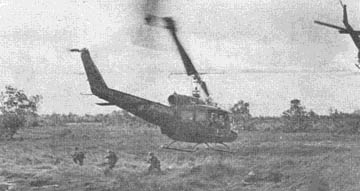 |
SCATTER, AND QUICKLY! Tropic Lightning soldiers of the 1st Brigade charge out of their choppers into the hot landing zone, even as the Hueys are on their way out. (PHOTO BY PFC RALPH NOVAK) |
Thanks to
Harold Touchette, 25th Aviation Bn., for sharing this issue,
Rita Adams for mailing the issue,
Kirk Ramsey, 2nd Bn., 14th Inf. for creating this page.
This page last modified 8-12-2004
©2004 25th Infantry Division Association. All rights reserved.